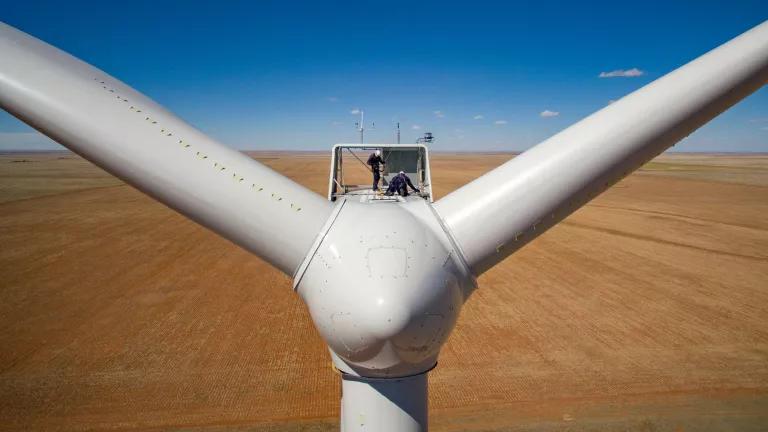How New Mexico Can Move Forward on Climate and a Just Transition
The bottom line is that, without significant new action, the state will not meet its targets to cut emissions and will not protect New Mexican communities from the clear, present, and increasing consequences of climate change.

Maintenance technicians working on a turbine at the Roosevelt Wind Project in New Mexico
New Mexico has taken important steps in recent years to confront climate change and support a just transition to clean energy that, together, will help protect people from hardship and suffering and pave the way to a prosperous future.
But state leaders need to move further, faster, and sooner to meet the rising costs we are seeing from wildfires, floods, drought, and extreme heat—all magnified by our unstable climate. Governor Michelle Lujan Grisham recently justified vetoing five clean energy tax incentives as being too small to “move the needle.”
If the governor and state officials want to make real climate progress right now, there are plenty of opportunities that could deliver big benefits in terms of job creation, health improvements, and economic growth for New Mexicans and would clearly move the needle.
These policies will benefit all New Mexicans, particularly those who have been disproportionately impacted by pollution from fossil fuels—for whom energy and housing are already unaffordable—or who might lose jobs from the transition to clean energy.
Fortunately, there is much the state can do today under existing laws to address the climate crisis and to lay the groundwork for in upcoming legislative sessions. With three and a half years to go, this administration can make enormous progress on climate by:
- Approving advanced clean car and truck rules this year;
- Updating the state building code;
- Adopting energy efficiency appliance standards;
- Allocating Community Energy Efficiency Development (CEED) block grants to fund low-income weatherization and clean, safe, and efficient affordable housing;
- Disbursing Economic Development Department funds to support community-driven clean and just transitions; and
- Ensuring that New Mexicans receive tax credits and incentives from the federal Inflation Reduction Act to help buy electric vehicles; add clean energy appliances and heat pumps to their homes and apartments; and install solar energy systems that will lower energy bills.
Governor Lujan Grisham’s administration marked a turning point from the polices of the previous administration. Starting in 2019, the state made significant advancements in clean energy and community transition policies and investments.
The Energy Transition Act; the creation of the Sustainable Economy Task Force and advisory council; new methane and ozone standards for oil and gas; the first updated building code in nearly a decade; new state and utility investments in transportation electrification; and the first steps toward clean vehicle standards are just some of the significant new polices of the Lujan Grisham administration’s first term.
Still, New Mexico’s climate task force, created by a January 2019 executive order, has made it clear that much more must be done to cut climate pollution if we want to lead the way toward a just, sustainable, and clean economy.
This recent session—despite the ill-conceived vetoes of climate tax provisions and the failure of any comprehensive climate legislation—saw significant new investments in affordable housing and in the state agencies that enforce environmental protections and develop new policies.
Here is a fuller list of policy priorities to act on in addressing the climate crisis.
Cleaner transportation
Transportation is the largest source of climate-changing pollution nationally and the second-largest source after oil and gas in New Mexico. Fortunately, the state can take advantage of federal funds and advanced state rules to curb emissions from cars and trucks and support more livable, safe neighborhoods and equitable access to transportation options.
Policy
- Adopt the updated clean cars and trucks standards in 2023 before we miss another year of bringing cleaner vehicles to New Mexico. These straightforward rulemakings should come before the more controversial, more complicated, and less impactful Clean Fuels program, which has so far failed to gain legislative approval after three attempts. The state can approve these car and truck standards now.
- Ensure that the state Department of Transportation evaluates all road investments to incorporate pedestrian crossings, sidewalks, bike lanes, and safety features. Support increased public transit investment. The state can enact this now, and further legislation would be useful.
Affordable housing
Many New Mexicans face unaffordable housing and high energy bills. The state is making investments in affordable housing and can speed up implementation of recent policies and new efficiency rules for new construction to ensure more New Mexicans have access to affordable, clean, healthy, and energy-efficient homes. The state can act now on each item below and further legislative action would be useful.
Policy/investment
- Commit $500 million over 10 years to support energy efficiency and weatherization improvements for all low-income homes in New Mexico.
- Invest in new affordable housing that utilizes clean electricity for heating and cooling and offers efficiently located electrical vehicle (EV) charging stations.
- Adopt the most updated energy efficiency building codes and appliance standards available.
- Require that all new buildings and parking facilities have solar and EV charging capacity.
- Fully implement the Sustainable Building Tax Credit and CEED block grants and seek federal funds for further support of efficient, healthy buildings and homes.
Just transitions
The burdens of climate change and our fossil fuel–based economy are not distributed evenly. Communities of color, low-income communities, immigrants, and tribal communities face greater negative impacts and risks from pollution, job insecurity, and dangerous work. Further, these same communities often face more obstacles in accessing solutions such as transitioning their energy sources, accessing tax credits, and more.
The state is beginning to make investments in supporting community voices and a just transition, but we must make sure that these investments are directed toward new, clean, and community-directed opportunities, not captured by fossil fuel interests. The state can act now, and further legislative action would help.
Policy
- Transformational planning, community engagement, and long-term investments to create job opportunities for oil and gas workers and working families in regions disproportionately impacted by climate change—including sustainable, safe, good-paying jobs—can ensure a meaningful and sustainable economy for all New Mexicans.
Pollution limits
New Mexico’s recent methane and ozone precursor rules are the first big step toward requiring the biggest polluters to reduce pollution or be held accountable. The state is also investing more resources in state agencies to implement and enforce these and other environmental rules. However, because of the explosive growth of the oil and gas industry in the state, more must be done to cut pollution from these and other sources to reduce air quality impacts on New Mexico communities and take steps toward a stable climate. The state can act now, and further legislation would be useful.
Policy
- Require large pollution sources—like oil refineries, gas-processing plants, compressor stations, manufacturing plants, and landfills—to slash their health- and climate-harming pollution.
- Ensure methane gas and smog safeguards are working and that state agencies have sufficient budgets to inspect and enforce them. Establish a process to evaluate further carbon and methane reduction requirements from oil and gas.
Energy utilities
The Energy Transition Act and the transportation electrification planning and investments authorized in 2019 shifted utilities in New Mexico in a new direction toward supporting renewable energy and clean energy technologies. Since then, the costs of clean energy have dropped and the federal government has invested billions in clean energy and technologies to prioritize clean electricity in transportation and buildings to displace fossil fuel. Now, utilities can move even faster to cut carbon pollution and support cleaner buildings as well as transportation.
Policy
- The Public Regulation Commission can ensure utilities are making smart investments today to speed decarbonization. The legislature can also give more authority to build on current law and speed utilities’ shift from polluting electricity sources. The state should require utilities to support bolder investments to electrify our cars, homes, and buildings. It can act now, and further legislation would be useful.
Summing up, New Mexico still has the potential to be a leader in equitable climate progress and has begun to build the foundations of a clean energy economy, but more can be done to invest in communities and support New Mexicans to participate in and benefit from a clean and just energy transition.
At the same time, funds that the legislature has already authorized must be used wisely: Hydrogen is only a climate solution if it is produced with renewable energy and used for hard-to-electrify end uses. Community transition investments are needed and must be community-led.
The bottom line is that, without significant new action, the state will not meet its targets to cut emissions and will not protect New Mexican communities from the clear, present, and increasing consequences of climate change.
It is time to get moving.




